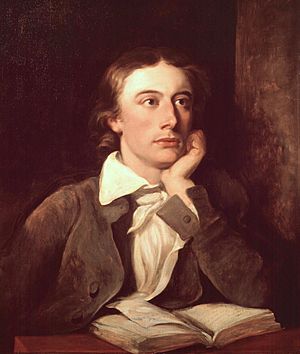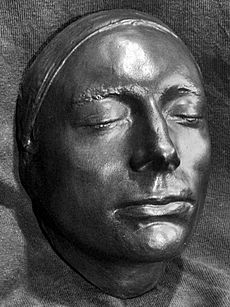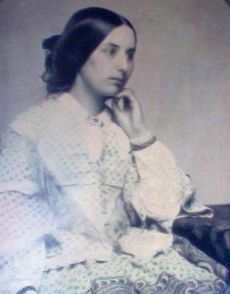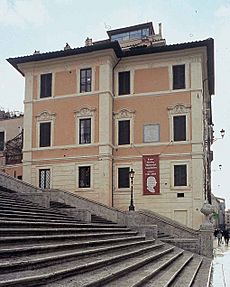John Keats facts for kids
Quick facts for kids
John Keats
|
|
|---|---|

Posthumous portrait of Keats by William Hilton, National Portrait Gallery, London (c. 1822)
|
|
| Born | 31 October 1795 Moorgate, London, England |
| Died | 23 February 1821 (aged 25) Rome, Papal States |
| Cause of death | Tuberculosis |
| Occupation | Poet |
| Literary movement | Romanticism |
| Relatives | George Keats (brother) |
John Keats (born October 31, 1795 – died February 23, 1821) was a famous English poet. He was one of the "Romantic poets," like Lord Byron and Percy Bysshe Shelley. Keats wrote poems for less than four years before he died from tuberculosis at just 25 years old.
At first, people didn't think much of his poems. But after he died, his fame grew very quickly. By the end of the 1800s, he was seen as one of the most important English writers. Today, his poems and letters are still very popular. Some of his most famous works include "Ode to a Nightingale" and "Ode on a Grecian Urn."
Contents
Early Life and School (1795–1810)
John Keats was born in Moorgate, London, England. This was on October 31, 1795. His parents were Thomas and Frances Keats. John was the oldest of four children who lived. His younger siblings were George, Thomas, and Frances Mary, also called Fanny.
His father worked at an inn called the Swan and Hoop. The family lived there for some years. John's parents wanted to send their sons to famous schools. But they couldn't afford the fees.
In 1803, John went to John Clarke's school in Enfield. This school was small and had new ideas for teaching. At Clarke's school, Keats became very interested in old stories and history. These interests stayed with him his whole life. The headmaster's son, Charles Cowden Clarke, became a good friend. He showed Keats many great books from the Renaissance period.
When Keats was eight, in April 1804, his father died. His mother remarried soon after. But she left her new husband. The four children then went to live with their grandmother.
In March 1810, Keats's mother died from tuberculosis. Keats was 14 years old. His grandmother then chose two guardians for the children. That autumn, Keats left school. He became an apprentice to Thomas Hammond. Hammond was a surgeon and apothecary (a type of pharmacist).
Becoming a Poet
In October 1815, Keats finished his apprenticeship. He then started studying medicine at Guy's Hospital in London. After only a month, he became a "dresser" at the hospital. This meant he helped surgeons during operations. It was a big step up and showed he was good at medicine. His family thought he would become a doctor. This would give him a secure job.
But Keats started spending more time writing. He felt torn between medicine and poetry. He wrote his first known poem, "An Imitation of Spenser," in 1814. He was 19 then. He was inspired by other poets like Leigh Hunt and Lord Byron. Keats also faced money problems with his family. He sometimes felt sad. His brother George said John worried he would never be a poet.
In 1816, Keats got his license to work as an apothecary, doctor, and surgeon. But by the end of that year, he told his guardian he wanted to be a poet instead.
His Writing Career
Even though he continued some medical training, Keats spent more time on literature. He tried different ways of writing poems. He especially liked writing sonnets.
He became friends with the poet and editor James Henry Leigh Hunt. In May 1816, Hunt published Keats's sonnet "O Solitude." It appeared in Hunt's magazine, The Examiner. This was the first time Keats's poetry was printed.
Keats only wrote actively for about six years. This was from 1814 to 1819. Because he died young, he wrote fewer poems than many other poets. His longest poems, Endymion and Hyperion, tell stories from ancient Greek mythology. Many of his shorter poems are very famous. These include the ballad "La Belle Dame sans Merci" and his many sonnets and odes.
Fanny Brawne
Keats first met Frances (Fanny) Brawne in late 1818.
In April 1819, Fanny and her mother moved into a house next to Keats's home. This meant Keats and Fanny could see each other every day. Keats started lending Fanny books. They would read together. He gave her his love sonnet "Bright Star." This poem became linked to their relationship. He kept working on it until his last months.
Keats wrote many letters to Fanny. In one letter from October 1819, he wrote about his deep love for her. He said his life seemed to stop without her. He felt he could die for his love for her.
At this time, Keats was already sick with tuberculosis. Doctors told him to move to a warmer place. In September 1820, he left for Rome, Italy. He knew he would likely never see Fanny again. After leaving, he found it too hard to write to her. He also couldn't read her letters. He did write to her mother, though. He died in Rome five months later. None of Fanny's letters to Keats have survived.
It took a month for the news of his death to reach London. Fanny mourned for six years. In 1833, more than 12 years after Keats died, she got married. She had three children and lived more than 40 years longer than Keats.
Death in Rome (1821)
John Keats died in Rome on February 23, 1821. He was buried in the city's Protestant Cemetery. His last wish was for his tombstone to have no name or date. He only wanted the words: "Here lies One whose Name was writ in Water."
His friends put up the tombstone. It has a broken lyre (a musical instrument) carved on it. Below that, it says:
This Grave / contains all that was Mortal, / of a / YOUNG ENGLISH POET, / Who, / on his Death Bed, / in the Bitterness of his Heart, / at the Malicious Power of his Enemies, / Desired / these Words to be engraven on his Tomb Stone / Here lies One / Whose Name was writ in Water / Feb 24th 1821
His Letters
Keats's letters were first printed in 1848 and 1878. In the 1800s, people didn't think his letters were important. They thought they took away from his poems. But in the 1900s, his letters became very popular. They are now studied almost as much as his poetry. Many people think they are some of the best letters ever written by an English poet. T. S. Eliot, a famous poet, called them "certainly the most notable and most important ever written by any English poet."
Major Works
- The Complete Poems (edited by Miriam Allott, 1970)
- Selected Letters of John Keats (edited by Grant F. Scott, 2002)
- The Poems of John Keats (edited by Jack Stillinger, 1978)
- The Letters of John Keats 1814–1821, 2 vols. (edited by Hyder Edward Rollins, 1958)
Images for kids
-
Wentworth Place, now the Keats House museum (left), Ten Keats Grove (right), Hampstead Heath, London
See also
 In Spanish: John Keats para niños
In Spanish: John Keats para niños






